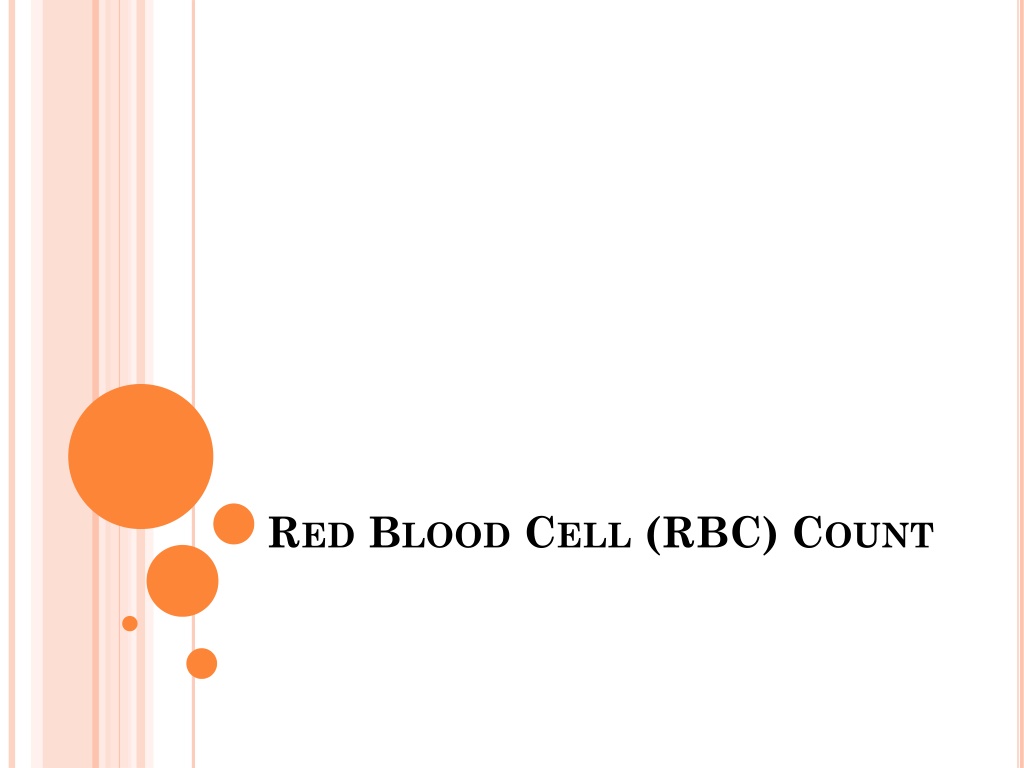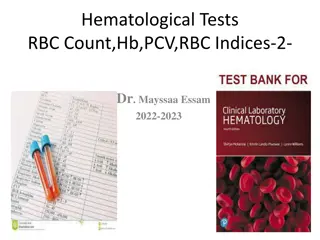Understanding Red Blood Cell (RBC) Count and Its Significance in Blood Health
Red blood cells, comprising nearly 45% of blood volume, play a crucial role in oxygen transport. The red blood cell count, measured as the number of cells per unit volume of blood, helps assess the adequacy of oxygen-carrying capacity. Normal values vary by age and gender. The experiment aims to determine RBC levels through manual and electronic methods, essential for evaluating overall blood health. The manual procedure involves using specific materials and instruments like Hayem's solution, RBC pipette, and a haemocytometer chamber. The process includes finger prick, dilution, and cell counting techniques. This comprehensive guide provides insights into conducting RBC count assessments effectively.
Download Presentation

Please find below an Image/Link to download the presentation.
The content on the website is provided AS IS for your information and personal use only. It may not be sold, licensed, or shared on other websites without obtaining consent from the author. Download presentation by click this link. If you encounter any issues during the download, it is possible that the publisher has removed the file from their server.
E N D
Presentation Transcript
INTRODUCTION Red blood cells make up almost 45 percent of the blood volume. Their primary function is to carry oxygen from the lungs to every cell in the body. Red blood cells are composed of a protein called hemoglobin and iron
N NORMAL ORMAL VALUE VALUE The red blood cell count:- is the number of red blood cells per unit volume of whole blood. Normal red blood cells values at various ages are: Adults (males): 4.9-5.5 million (Females): 4.4-5.0 million
AIM OF THE EXPERIMENT RBC count is done to determine whether there is an adequate number of RBC in the circulation or not.
METHODS 1- Manual method 2-Electronic cell counting
MANUAL RED BLOOD CELL COUNT MATERIAL AND INSTRUMENTS Anticoagulated whole (using EDTA or heparin as an anticoagulant) or capillary blood can be used. Hayem s solution (diluting fluid) RBC pipette which is composed of a stem & a mixing chamber with a red bead, it is function is to mix blood with the substance and for differentiation from the WBC pipette.
Haemocytometer chamber is counting chamber with a cover slip. The same counting chamber is used also for counting total white blood cells. Microscope Lancet Alcohol 70% Cotton
PROCEDURE 1. Wipe your partener s finger with cotton soaked with alcohol and allow it to dry. With a sterile disposable lancet do small prick on the finger tip, hold the red blood cell pipette slightly tilted from the vertical position, apply its tip to the drop and aspirate blood to the mark 0.5.
Procedure 2. Aspirate diluting Hayem s solution to the 101 mark, thus making 1:200 dilution of blood. 3. Hold the pipette horizontally and role it with both hands between finger and thumb.
4. Blow out a quarter of the content to remove the pure diluting fluid in the stem. 5. Prepare the counting chamber and cover it with a cover slip. Hold the pipette 45 & touch its tip gently on the surface of the counting platfrom where it projects beyond the cover slip and a small amount of solution will be drawn under the cover slip. 6. Scan the counting area with 10x objective lens. 7. Use the 40x objective to count cells.
Count the cells in 5 medium squares of 16 small squares one at each corner and one in the center. Hemocytometer Chamber
CALCULATION To calculate the number of RBCs in a mm3 of blood, this formula is used: RBCs/mm3 of blood = Total number of RBCs counted in R1-R5 X dilution X 4000Number of small squares counted If the blood dilution is 1:200 and if all of the RBCs in the 16 small squares within each of the 5 R squares are counted, the formula is simplified to:RBCs/mm3 = Number of RBCs counted X 10,000.























